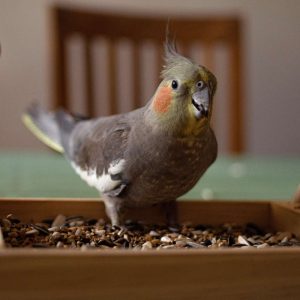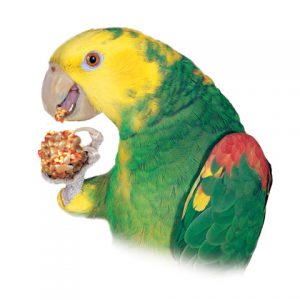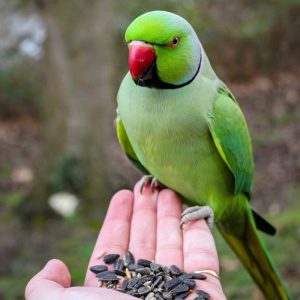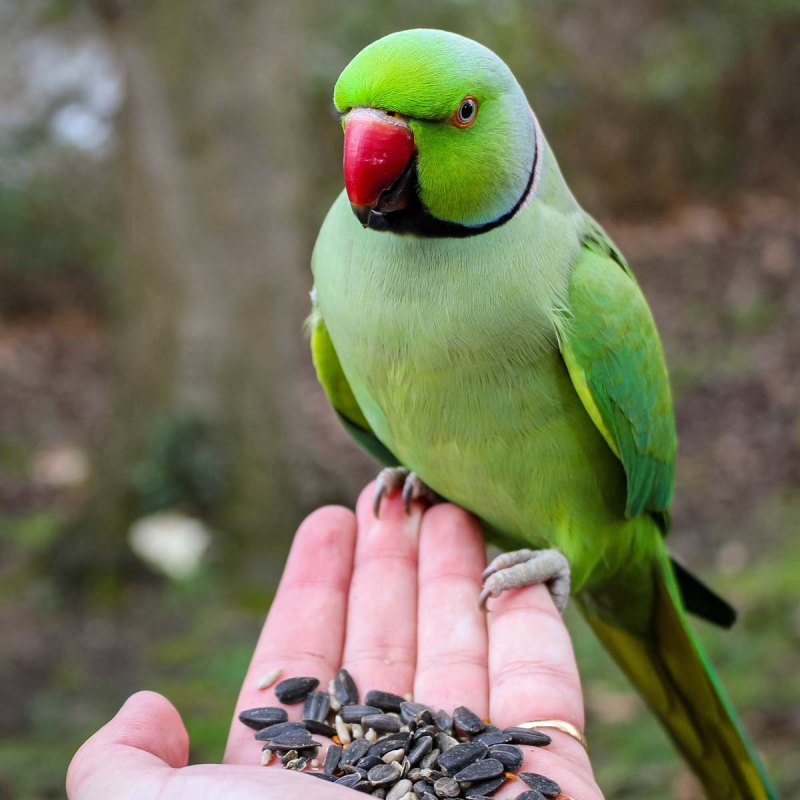
When pet bird owners go to their veterinarian or bird-savvy pet store, they are often informed that pellets or Nutri-Berries are better than seeds as the major portion of the diet. But what is the difference really?
Pellets, and other formulated diets like Nutri-Berries, are created to have a balanced ratio of nutrients packed into a single unit. These formulations are based off research done in granivorous birds, including chickens, budgerigars, and cockatiels. We still need to learn a lot about pet parrot nutritional requirements, but pellets provide a much better balance of nutrients than seeds.
Seed mixes that are typically found in pet bird diets are unbalanced in various nutrients. Both deficiencies and excesses occur when a bird is fed these as the main part or only component of their diet. Seeds can and do lead to many health problems if they are fed in inappropriate quantities and ratios in the diet.
When comparing pellets and seeds on a nutrient level, researchers and avian veterinarians have identified several key differences. Following is a list of the unbalanced nutrients that occur in seed-based diets, how these nutrients are important for life, and the effects for a bird not having these nutrients adequately provided.
Deficiencies Of A Seed-Only Diet
Calcium & Phosphorus

Seeds are insufficient in calcium and often have an imbalance in their calcium to phosphorus ratio. Calcium is one of the most commonly discussed minerals in birds, particularly because of its vital role in reproduction and egg laying. Calcium is required to form the shell of an egg; however, it is also required in the body for normal bone health, nervous system functioning, and muscle health. Deficiencies can result in egg binding, impaired bone development, thin eggshells, poor uterine contractions and neurologic signs like seizures.
Phosphorus is a mineral that functions closely with calcium. The ratio of calcium to phosphorus is important and should be about 2 parts calcium to 1 part phosphorus. Seeds are often unbalanced with this ratio and have calcium in lower amounts and phosphorus in higher amounts. Deficiencies in phosphorus or imbalances in the calcium-to-phosphorus ratio can result in weakness, rickets, and thin-shelled eggs. Excessive amounts of phosphorus can interfere with the absorption of calcium from the intestinal tract and induce a condition known as nutritional secondary hyperparathyroidism. Although any pet bird can experience imbalances in these nutrients when fed a seed-based diet, African Grey parrots are well-known for deficiencies in calcium , which can cause seizure activity and poor bone development in young individuals.
Sodium
Sodium is an important element for cell signaling and electrical conductance. Seeds do not supply ample amounts of this, which can result in deficiencies that cause poor egg production and poor growth.
Zinc
Zinc functions as a cofactor for many different enzymes and is important for growth, reproduction, and tissue healing. Low levels of zinc found in seeds can result in poor growth, thicker and shorter long bones, scaling of the feet and skin, and poor feathering.
Iron
Iron’s importance lies in the fact that it is involved in cellular respiration. It is complexed with the protein known as heme, and it helps transport oxygen around the body to tissues. Diets that are exclusively seeds are low in this element, and deficiencies can lead to anemia.
Lysine/Methionine

These are both proteins and are just two of the approximately 20 amino acids that are necessary for life. Proteins have a wide variety of functions within the body. They act as enzymes to catalyze reactions. Both lysine and methionine have structural properties and make up portions of muscles and collagen. They act as transports of compounds both within and outside of cells. Both function in the bloodstream, both to help with the immune system and with clotting blood. Their list of functions can go on and on. Deficiencies in lysine and methionine are common with seed-based diets and have been associated with liver disease in birds.
Vitamin A
Vitamin A is a fat-soluble vitamin that is important in vision, immune system health, and in cells that line the skin, respiratory tract, reproductive tract, kidneys, and glandular tissues. Deficiencies in this nutrient are very common for seed diets and can result in a change in the superficial epithelial cells of the previously mentioned tissue. This can then result in various problems, such as sinus infections, kidney disorders, and reduced fertility and hatchability of eggs.
Vitamin B
There are several B vitamins, but there are just a few that seeds are often lacking.
- Vitamin B2 is also known as riboflavin. It is also important for carbohydrate metabolism. In cockatiels that are growing, a deficiency in this vitamin will cause achromatosis, which is a loss of normal pigmentation to the feathers. It can also cause a reduction of eggs in a clutch and reduced hatching of eggs.
- Vitamin B9 is folic acid. This works as a cofactor in the synthesis of purines, which is a component of DNA. Low levels will result in slow growth, poor feathering, anemia, reduced egg production and hatchability, and boney abnormalities in embryos and growing birds.
- Vitamin B12 is cobalamin. It functions as a coenzyme and is involved in fat and protein metabolism and the synthesis of DNA. Deficiencies will result in anemia. They can also result in a fatty liver, heart, and kidneys.
- Choline is often grouped with B vitamins due to similarities that they have. It is important for normal nervous system and liver health. Birds with deficiencies in this nutrient have been found to suffer from fatty liver disease.
Notable Excesses Of A Seed-Only Diet
Fats
Seeds are undoubtedly high in fat. Take, for example, the sunflower seed. For this delicious food item that many pet birds relish, 74% of the dry matter is fat! That is a very high volume. With sunflower seeds being a common item found in seed mixes, you can see how it could easily become an excessive amount of fat if the bird were to consume it frequently. Too much fat in the diet can lead to various problems, including liver disorders, heart problems, reproductive disorders, and obesity.
Be In The Know
Exploring and understanding the difference between the nutrients in seeds and pellets helps you see just how important it is that birds receive more balanced nutrition. If birds continue to eat seeds for the greater part of their meals, nutritional imbalances can eventually catch up and cause major health concerns. However, providing pellets or Nutri-Berries as a portion of the diet ensures a more adequate nutrient profile. This goes a long way to prevent certain disorders and allow for a much healthier life.
More Parrot Nutrition Info:
1. Toft CA, Wright TF. (2015) The thriving parrot: The foods and beaks of parrots. In: Parrots of the wild: A natural history of the world’s most captivating birds. Eds Toft CA, Wright TF. University of California Press, Oakland. pp 39-80
2. Koutsos E, Gelis S, Echols MS. (2016) Advancements in nutrition and nutritional therapy. In: Current therapy in avian medicine and surgery. Ed Speer BL. Elsevier, St. Louis. pp 142-176
3. Harper J, Skinner ND. (1998) Clinical nutrition of small psittacines and passerines. Semi Exot Pet Med 7: 116-127
4. Brightsmith DJ. (2012) Nutritional levels of diets fed to captive Amazon parrots: Does mixing seed, produce and pellets provide a health diet? J Avian Med Surg 26:149-160
5. Harrison GJ. (1998) 43 Years of progress in pet bird nutrition. AVMA vol 212, No 8, April 15 1998 p1226-1230
6. Nijboer J. (2015) Nutrition in Psittacines. Online Merck Manual Veterinary Manual
7. Koutsos EA, Matson KD, Klasing KC. (2001) Nutrition of birds in the order psittaciformes: a review. J. Avian Med Surgery 15(4):257–275
8. Butcher GD, Miles RD. (1993) Understanding Pet Bird Nutrition. CIR1082, Veterinary Medicine-Large Animal Clinical Sciences Department, UF/IFAS Extension
